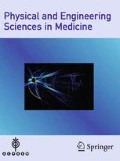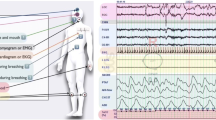Abstract
Obstructive sleep apnea is a disease that occurs in connection to pauses in respiration during sleep. Detection of the disease is achieved using a polysomnography device, which is the gold standard in diagnosis. Diagnosis is made by the steps of sleep staging and respiration scoring. Respiration scoring is performed with at least four signals. Technical knowledge is required for attaching the electrodes. Additionally, the electrodes are disturbing to an extent that will delay the patient’s sleep. It is needed to have systems as alternatives for polysomnography devices that will bring a solution to these issues. This study proposes a new approach for the process of respiration scoring which is one of the diagnostic steps for the disease. A machine-learning-based apnea detection algorithm was developed for the process of respiration scoring. The study used Photoplethysmography (PPG) signal and Heart Rate Variability (HRV) that is derived from this signal. The PPG records obtained from the patient and control groups were cleaned out using a digital filter. Then, the HRV parameter was derived from the PPG signal. Later, 46 features were derived from the PPG signal and 40 features were derived from the HRV. The derived features were classified with reduced machine-learning techniques using the F-score feature-selection algorithm. The evaluation was made in a multifaceted manner. Besides, Principal Component Analysis was performed to reduce system input (features). According to the results, if a real-time embedded system is designed, the system can operate with 16 PPG feature 95%, four PPG feature 93.81% accuracy rate. These success rates are highly sufficient for the system to work. Considering all these values, it is possible to realize a practical respiration scoring system. With this study, it was agreed upon that PPG signal may be used in the diagnosis of this disease by processing it with machine learning and signal processing techniques.











Similar content being viewed by others
References
Berry RB, Budhiraja R, Gottlieb DJ, Gozal D, Iber C, Kapur VK, Marcus CL, Mehra R, Parthasarathy S, Quan SF, Redline S, Strohl KP, Davidson Ward SL, Tangredi MM (2012) Rules for scoring respiratory events in sleep: update of the 2007 AASM Manual for the Scoring of Sleep and Associated Events. Deliberations of the Sleep Apnea Definitions Task Force of the American Academy of Sleep Medicine. J Clin Sleep Med 8(5):597–619
Al-Khammasi S, Aboalayon KAI, Daneshzand M, Faezipour M, Faezipour M (2017) Hardware-based FIR filter implementations for ECG signal denoising: A monitoring framework from industrial electronics perspective. In: 2016 annual connecticut conference on industrial electronics, technology and automation, CT-IETA 2016, IEEE, pp 1–6
Changyue S, Kaibo L, Xi Z, Lili C, Xiaochen X (2015) An obstructive sleep apnea detection approach using a discriminative hidden markov model from ECG signals. IEEE Trans Biomed Eng 63:1532
Bruyneel M, Ninane V (2014) Unattended home-based polysomnography for sleep disordered breathing: current concepts and perspectives. Sleep Med Rev 18(4):341–7
Uçar MK, Bozkurt MR, Bilgin C, Polat K (2016) Automatic detection of respiratory arrests in OSA patients using PPG and machine learning techniques. Neural Comput Appl 28:2931–2945
Jezzini A, Ayache M, Elkhansa L, Ibrahim ZAA (2015) ECG classification for sleep apnea detection. In: 2015 international conference on advances in biomedical engineering (ICABME), IEEE, pp 301–304
Xie B, Minn H (2012) Real-time sleep apnea detection by classifier combination. IEEE Trans Inf Technol Biomed 16(3):469–477
Lazaro J, Gil E, Vergara JM, Laguna P (2012) OSAS detection in children by using PPG amplitude fluctuation decreases and pulse rate variability. Comput Cardiol 2012:185–188
Kim MS, Cho YC, Seo S-T, Son C-S, Kim Y-N (2012) Comparison of heart rate variability (HRV) and nasal pressure in obstructive sleep apnea (OSA) patients during sleep apnea. Measurement 45(5):993–1000
Penzel T, Kantelhardt JW, Becker HF, Peter JH, Bunde A (2003) Detrended fluctuation analysis and spectral analysis of heart rate variability for sleep stage and sleep apnea identification. In: Computers in cardiology, 2003, IEEE, pp 307–310
Gaurav G, Mohanasankar S, Jagadeesh Kumar V (2013) Apnea sensing using photoplethysmography. In: 2013 seventh international conference on sensing technology (ICST), IEEE, pp 285–288
Yilmaz B, Asyali MH, Arikan E, Yetkin S, Ozgen F (2010) Sleep stage and obstructive apneaic epoch classification using single-lead ECG. Biomed Eng 9(1):39
Rolón RE, Larrateguy LD, Di Persia LE, Spies RD, Rufiner HL (2017) Discriminative methods based on sparse representations of pulse oximetry signals for sleep apnea-hypopnea detection. Biomed Signal Process Control 33:358–367
Hassan AR (2016) Computer-aided obstructive sleep apnea detection using normal inverse Gaussian parameters and adaptive boosting
Hassan AR, Aynal Haque M (2017) An expert system for automated identification of obstructive sleep apnea from single-lead ECG using random under sampling boosting. Neurocomputing 235:122–130
Sharma H, Sharma KK (2016) An algorithm for sleep apnea detection from single-lead ECG using Hermite basis functions. Comput Biol Med 77:116–124
Karmakar C, Khandoker A, Penzel T, Schobel C, Palaniswami M (2014) Detection of respiratory arousals using photoplethysmography (PPG) signal in sleep apnea patients. IEEE J Biomed Health Inform 18(3):1065–1073
Annakkaya AN, Balbay Ö, Bilgin C, Erbafi M, Arbak P (2004) Outcomes of the eight-channel ambulatory recording unit in a sleep laboratory. Eurasian J Pulmonol 6(1):12–23
Fang Y, Jiang Z, Wang H (2018) A novel sleep respiratory rate detection method for obstructive sleep apnea based on characteristic moment waveform. J Healthc Eng 2018:1–10
Almazaydeh L, Elleithy K, Faezipour M, Abushakra A (2013) Apnea detection based on respiratory signal classification. Procedia Comput Sci 21:310–316
Köktürk O (1998) Uykuda solunum bozuklukları. Tarihçe, tanımlar, hastalık spektrumu ve boyutu. Tüberküloz ve Toraks Dergisi 46(2):187–192
Ucar MK, Bozkurt MR, Polat K, Bilgin C (2015) Investigation of effects of time domain features of the photoplethysmography (PPG) signal on sleep respiratory arrests. In: 2015 23nd signal processing and communications applications conference (SIU), IEEE, pp 124–127
Wallisch P, Lusignan ME, Benayoun MD, Baker TI, Dickey AS, Hatsopoulos NG (2014) MATLAB for neuroscientists. Elsevier, Amsterdam
Shi P, Zhu Y, Allen J, Sijung H (2009) Analysis of pulse rate variability derived from photoplethysmography with the combination of lagged Poincaré plots and spectral characteristics. Med Eng Phys 31(7):866–71
Dehkordi P, Garde A, Karlen W, Wensley D, Ansermino JM, Dumont GA (2014) Sleep stage classification in children using photoplethysmogram pulse rate variability. In: Computing in cardiology conference (CinC), IEEE, pp 297–300
Polat K, Güneş S (2009) A new feature selection method on classification of medical datasets: kernel F-score feature selection. Expert Syst Appl 36(7):10367–10373
Şahan S, Polat K, Kodaz H, Güneş S (2007) A new hybrid method based on fuzzy-artificial immune system and k-nn algorithm for breast cancer diagnosis. Comput Biol Med 37(3):415–23
Khan M, Ding Q, Perrizo W (2002) k-Nearest neighbor classification on spatial data streams using P-trees. Springer, Berlin, pp 517–528
Farajzadeh J, Fard AF, Lotfi S (2014) Modeling of monthly rainfall and runoff of Urmia lake basin using “feed-forward neural network” and “time series analysis” model. Water Resour Ind 7–8:38–48
Zounemat-kermani M, Kisi O, Rajaee T (2013) Performance of radial basis and LM-feed forward artificial neural networks for predicting daily watershed runoff. Appl Soft Comput 13(12):4633–4644
Khamis A, Shareef H, Mohamed A, Bizkevelci E (2015) Islanding detection in a distributed generation integrated power system using phase space technique and probabilistic neural network. Neurocomputing 148:587–599
Parzen E (1962) On estimation of a probability density function and mode. Ann Math Stat 33(3):1065–1076
Wasserman PD (1993) Advanced methods in neural computing, 1st edn. Wiley, New York
Cortes C, Vapnik V (1995) Support-vector networks. Mach Learn 20:273–297
Mandhala VN, Sujatha V, B Renuka Devi (2014) Scene classification using support vector machines. In: 2014 IEEE international conference on advanced communications, control and computing technologies, IEEE, pp 1807–1810
Rokach L, Schclar A, Itach E (2014) Ensemble methods for multi-label classification. Expert Syst Appl 41(16):7507–7523
Ramachandran KM, Tsokos CP (2015) Mathematical statistics with applications in R. Elsevier, Boston
Alpar R (2010) Applied statistic and validation—reliability. Detay Publishing, Ankara
Uçar MK, Bozkurt MR, Bilgin C, Polat K (2018) Automatic sleep staging in obstructive sleep apnea patients using photoplethysmography, heart rate variability signal and machine learning techniques. Neural Comput Appl 29:1–16
Addison PS (2017) Respiratory effort from the photoplethysmogram. Med Eng Phys 41:9–18
Orphanidou C (2017) Derivation of respiration rate from ambulatory ECG and PPG using ensemble empirical mode decomposition: comparison and fusion. Comput Biol Med 81:45–54
Liu Z, Sun J, Zhang Y, Rolfe P (2016) Sleep staging from the EEG signal using multi-domain feature extraction. Biomed Signal Process Control 30:86–97
Funding
This research was supported by The Scientific and Technical Research Council of Turkey (TUBITAK) through The Research Support Programs Directorate (ARDEB) with project number of 115E657, and project name of “A New System for Diagnosing Obstructive Sleep Apnea Syndrome by Automatic Sleep Staging Using Photoplethysmography (PPG) Signals and Breathing Scoring” and by The Coordination Unit of Scientific Research Projects of Sakarya University.
Author information
Authors and Affiliations
Corresponding author
Ethics declarations
Conflict of interest
There is no conflict of interest between the authors.
Ethical approval
The ethics committee report numbered 16214662/050.01.04/70 from Sakarya University Deanship of Faculty of Medicine, and the data use permission numbered 94556916/904/151.5815 from T.C. Ministry of Health Turkey Public Hospitals Authority Sakarya Province General Secretariat of Association of Public Hospitals were received to perform the study. This article does not contain any studies with animals performed by any of the authors.
Informed consent
Informed consent was obtained from all individual participants included in the study.
Additional information
Publisher's Note
Springer Nature remains neutral with regard to jurisdictional claims in published maps and institutional affiliations.
Rights and permissions
About this article
Cite this article
Bozkurt, M.R., Uçar, M.K., Bozkurt, F. et al. In obstructive sleep apnea patients, automatic determination of respiratory arrests by photoplethysmography signal and heart rate variability. Australas Phys Eng Sci Med 42, 959–979 (2019). https://doi.org/10.1007/s13246-019-00796-9
Received:
Accepted:
Published:
Issue Date:
DOI: https://doi.org/10.1007/s13246-019-00796-9




